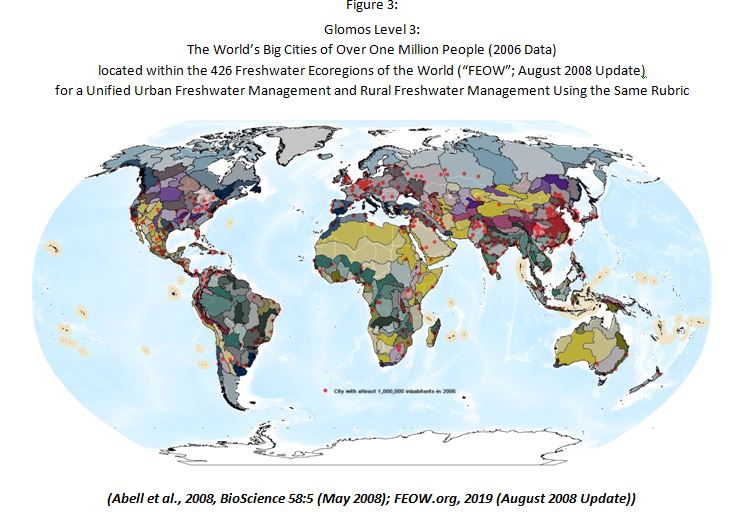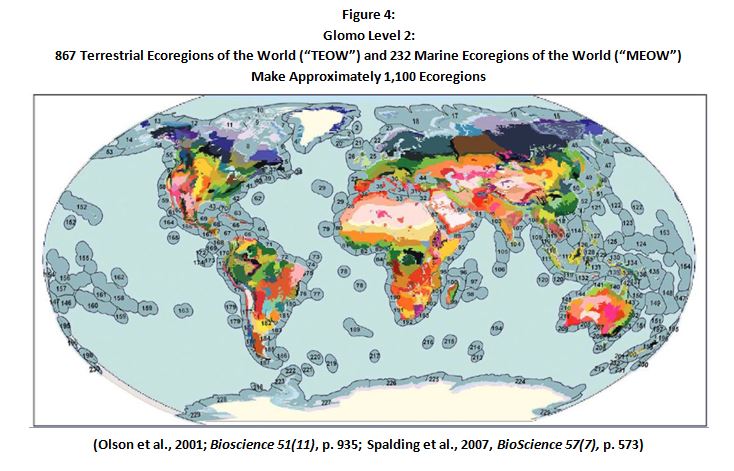Mark Whitaker on Global Modules as Nested Biospheres
This table and added explanation are an addendum to our page on the Glomo system, as proposed by Mark Whitaker and colleagues.
The Table of Nested Biospheres
| Nested Glomo levels | Nested Demographic/ Geographic Location | How nested human action at different levels fits in nested ecological zones | Estimated numbers |
|---|---|---|---|
| glomo5 | Urban neighbourhood or rural village biospheric action* | Urban neighborhoods and rural villages: based on nested watersheds | Unknown, numerous; millions of neighborhoods in hundreds of thousands of watersheds worldwide |
| glomo4 | Local urban-based and local rural-based biospheric action* | Urban boroughs, small towns, and rural counties: each based on larger nested watersheds, at requisite scales | Unknown, numerous; tens of thousands of local urban/rural areas in thousands of larger nested watersheds worldwide |
| glomo3 | Metropolitan*,** and rural territorial*** biospheric action |
Metropolitan big city conurbations*,**, and large rural provinces***: both based on freshwater ecoregions*** (some freshwater ecoregions in sister paired relationships with marine ecoregions; depending on geographic reality) |
~548 big cities (2018)** in the largest nested watershed level of 426 freshwater ecoregions worldwide*** |
| glomo2 | Land and marine ecoregion biospheric action**** | Territorial populations based in and influencing our land ecoregions and our marine ecoregions (some terrestrial ecoregions in sister paired relationships on the coast with freshwater ecoregions on land; depending on geographic reality) | ~1,099 territorial commonalities in ~1,099 total land and marine ecoregions**** worldwide |
| glomo1 | Planetary biospheric action***** | Planet Earth’s human population: based in and influencing our single planetary biosphere | One population on planet Earth |
Explaining Nested Biospheres
To explain the five uses of asterisks in the above table, detailed meanings of each are in the below discussion.
* This is the base Glomos level, beginning and arranging a water-based foundation for the wider nested, aligned, and thus magnified biospheric action. It begins from small sub-units of freshwater watersheds in glomo 5, then larger sub-units of the freshwater watersheds in glomo 4, and then finishes in the widest freshwater watershed possible, called a freshwater ecoregion, that has the full nested set of watersheds within it (glomo 3). So, in this aligned watershed nesting of glomo 5, 4, and 3, there is easier aggregated sustainable action as feedback in turn upon and within our terrestrial ecoregions and marine ecoregions of glomo 2 that are based on wider ecological realities that include yet are beyond watersheds.
Then, with this aligned land and marine ecoregional nesting of glomo 2, there is easier aggregated sustainable action as feedback in turn upon the full planetary biosphere of glomo 1. For the smaller watershed levels of glomo 5 or glomo 4, it is similar to the United States’ “hydrologic unit codes” (“HUCs” from U.S.’s E.P.A.) that are recommended as a clear yet nuanced way to do numbering or nomenclature of hydrologic mapping, via a nested six digit number of three two-digit parts. This nested numbering of watersheds is suggested to be used globally as a more ecological ‘area code’ as well. These nested numbers exist to map accurately the subsidiarity within larger freshwater ecoregions. Already, a global three-digit code is used to standardize the 426 Freshwater Ecoregions of the World (or “FEOW”, from Abell et al., 2008).
Therefore, it is suggested that the next project of the FEOW would be to take those 426 three-digit numbers then map their own subsidiary hydrological unit codes, worldwide, by placing other numbers after the base 426 three digit numbers, in order to map in more detail the nested watershed qualities of each of these 426 freshwater ecoregions—like has already been done by the U.S.’s E.P.A. in its hydrological unit codes. In short, a detailed project of worldwide, nested, hydrological unit codes based on adding subsidiary watershed numbers after the already enumerated 426 freshwater ecoregions has yet to be done by conservation biologists or biogeographers. However, it would be a useful project for the Glomos to have a series of globally standardized hydrological unit codes.
** “Big cities” are defined as cities of one million or more in population. However, the worldwide number of cities of one million or more in population is a moving target. In 2000, it was 371 big cities of one million or more. In 2006, it was 407. In 2018, it was 548. By 2030, it is projected to be approximately 706. See Figure 3 for a detailed world map of the locations of 407 big cities (from 2006). It would be a useful project for the Glomos to have an updated world map of the locations of these 548 (or more) big cities and where they are in reference within 426 freshwater ecoregions of the world (FEOW).
*** The estimated 426 Freshwater Ecoregions of the World, abbreviated as “FEOW” (Abell et al., 2008), are a useful modular and nested way to encapsulate current and diversely-sized human communities within similar approximated ecological boundaries to judge their improvement and common comparative impacts ultimately upon one factor: the health of unique fish populations in nested freshwater watershed flows, worldwide. This is because people, industries, and fish require freshwater equally, then, the health of regional freshwater fish, the healthiness of regional water flows, and the health of people are argued to be the three most shareable and comparable rubrics for monitoring regional impact assessment worldwide, i.e., monitoring both within and comparatively across the Glomos regions for improvement in all three metrics. Thus, more representative and sustainable feedback on freshwater problems is the most pragmatic shared biospheric human action for aligning simultaneous improvement in infrastructural-economic development, in human quality of life, in ecological life—and in rural and urban areas alike.
**** See Figure 4 below which is a merged map of the world’s many land-based terrestrial ecoregions and marine ecoregions of glomo 2. The phrase “TEOW” (Olson et al., 2001) is the abbreviation for “terrestrial ecoregions of the world.” There are approximately 846 to 867 terrestrial ecoregions depending on classification criteria. The phrase “MEOW” (Spalding et al., 2007) is the abbreviation for “marine ecoregions of the world.”
Currently, these are demarcated as 232 oceanic coastal ‘benthic’ zones (with ‘benthic’ defined as the many unique marine ecologies in coastal zones worldwide, measured to an ocean depth of 200 meters). The 232 marine ecoregions already are arranged in their own nested hydrological units with 12 marine biogeographic realms, 62 marine provinces, and 232 base marine ecoregions. This makes any of the 232 marine ecoregion identifiable easily for its own nested marine qualities by merging numbers for biographic realms, then, provinces, and then marine ecoregions. For example, to talk clearly about the nested marine qualities of, say, the Southern California Bight, this marine ecoregion would be numbered as 2:11:59 (with the Temperate North Atlantic being the second numbered biographic realm (2 of 12), and then there being 11 different biographic provinces within that biogeographic realm, with the sub-unit of the Warm Temperate Northeast Pacific (11 of 11) having three sub marine ecoregions within it, one of which being the Southern California Bight (given the marine ecoregion number 59). This means the total land ecoregions and the total oceanic benthic ecoregions of glomo 2 are approximately 1,100 (~867 terrestrial ecoregions + 232 marine benthic ecoregions = ~1,099 land/marine ecoregions).
Both land ecoregions and marine ecoregions of glomo 2 get nested feedback and improvement from the three common watershed-based glomo levels of 5, 4, and 3. Due to the real-world empirical variety of sizes of terrestrial and marine ecoregions of glomo 2, there are sometimes vast differences in geographic size or internal human population compared to each other. Therefore, it is argued that the only way effectively to have durable aligned pressure for sustainability, in other words, is to have all downstream land-based freshwater watersheds (of glomo 5, 4, and 3) that are linked to clear human settlements aligned in sustainable action themselves, in order to magnify and maintain their biospheric action and improvement upon wider terrestrial freshwater ecoregions (where sometimes few people live) or upon marine ecoregions downstream (where obviously almost zero people live though their terrestrial livelihoods do depend on such oceanic zones or pollute such oceanic zones.) Thus, glomo 2 benefits and is cleaned up from the aligned biospheric action of glomo 5, 4, and 3. Plus, glomo 2 continues the nesting principle as wider than a mere watershed nesting principle since glomo 2 encompasses nested watersheds and more in order to provide aligned representative and sustainable biospheric action within wider land-based ecologies and upon downstream marine ecoregions.
***** For our one single planetary geophysical biosphere to receive more representative biospheric action upon this global level, in turn, it should be aligned to accept democratic and sustainable feedback from all the nested Glomos, as what will clean it up. Otherwise, this global level goes rogue by lacking any clear connection to sustainable biospheric action from actual human communities. This is because actual human communities’ more localized geographic politics are far smaller than the biogeochemical cycles of the whole world. Thus, having all the other nested and aligned Glomos levels working together provides the best available representative and sustainable feedback for cleaning up the whole biophysical world which means cleaning up the social world of unrepresentative corruption and degradation against all rogue globalist human actors on the level of glomo 1.

